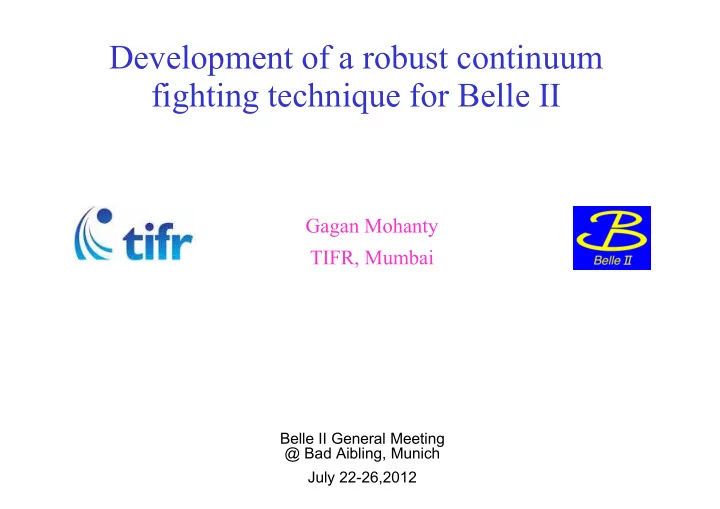

Development of a robust continuum fighting technique for Belle II Gagan Mohanty TIFR, Mumbai DHEP Seminar February Belle II General Meeting 2, 2012 @ Bad Aibling, Munich July 22-26,2012
What is the fuss about? Belle II aims to precisely examine the whole pattern of CP violation and to search for several SM-suppressed decays in the B meson system in its pursuit for the holy-grail of new physics beyond the SM uds:cc:bb = 2.1:1.3:1.1 Most dominant background is from e + e − → qq (q = u,d,s,c) continuum events – roughly ¼ times BF(B→X) at the Υ(4S) resonance 2
What is the current baseline? We mostly make use of the difference in event topology to distinguish spherical BB events from the jet-like continuum background Typical event-shape variables used are: 3
Add B-decay variables to the list Further discrimination is provided by the fact that in one side we have a B decay while prompt, continuum events on the other side Two variables of interest: Distance along the z -axis between the reconstructed B vertex and that of rest-of-the-event “recoil B” Product of flavor tagging output and quality factor (q.r) Colour legends are swapped between two plots (in the left plot signal is blue and continuum is red while in the right plot it is other way around) 4
Let’s look at q.r in some detail The philosophy behind flavor tagging is to distinguish between B 0 vs. B 0 ; not really optimized to separate continuum from B-decay events 5
What do we plan to do? The plan is to go behind each and every variable we think can provide useful discrimination against the continuum background Some variables we have thought about are The number of kaons (they are expected to be produced in “pairs” for The number of kaons (they are expected to be produced in “pairs” for the continuum background, especially for e + e − → ss events) Energy spectra of leptons (in BB events they mostly originate from a semi-leptonic decay and are expected to have higher momentum than that in continuum) Momentum of the daughter pions (they are relatively softer if their mother is a D * meson inside the charm continuum) 6
One typical variable Plots below show energy distributions for leptons (electrons/muons in the top/bottom row) from e + e − → uu, dd, ss (left), cc (middle) and a typical BB event (right) 7
Closing remarks We have just started this project few months back, actually due credit to Bruce Yabsley as the original proposer Need to put some more effort V.Gaur and another student would spend some time with this project Hope to have some more news by the November B2GM Thanks for your kind attention 8
Recommend
More recommend